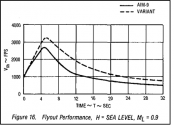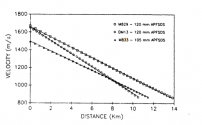But that's not how missiles work either.
Most non-air breathing missiles have rocket motors that burn out early (Boost phase), glide the rest of the way unpowered (Midcourse Phase) before engaging the target (Terminal Phase).
Take the RAM-116 RAM Block 0/1. The missile body is taken off that of the AIM-9L, which we are fortunate to have a lot of OSINT on.
View attachment 72525
This is the velocity curve of the AIM-9L. The RAM should be fairly similar to this.
What it shows is that the rocket burn out is at approx. 5s (when acceleration stops)
At T+5s, the missile will have flown a grand total of approx 2km.
Past 2km it is no different from any other gun projectile in that it is no longer being propelled.
Velocity loss is fairly steep up to the transonic region.
At approx T+10s, it will have flown about 5km with retained velocity at about 475m/s (approx M1.4)
Compare this with the DART projectile that at T+5s has also flown 5km with velocity still at approx. 800-900m/s.
Missile, T+10s to 5km, V=475m/s
DART, T+5s to 5km, V=800m/s
So I respectfully disagree with you. The DART projectile doesn't necessarily have inferior kinematics to a SHORAD missile. For engagements within T+5s/1.7km, when the missile still has significant delta vee, sure, the missile is definitely better. Past that, it would seem to be advantage DART based on raw kinetics. Yes, there are other factors but the principle behind the DART seems pretty sound if a tad misunderstood by some.
Note:
The above is based on the AIM-9L which includes the initial V0 of M0.9 provided by the launch platform (an aircraft). The RAM launches from a pretty much stationery platform which means it burns out at a lower speed (lets call it M2.0) and closer to the launch platform (lets ballpark it at about 1.7km) with a velocity at T+10s very close to M1.0 (about 340m/s), which means it will come out worse than an air-launched AIM-9L unless we have OSINT that indicates what improvements (if any) have been made.


